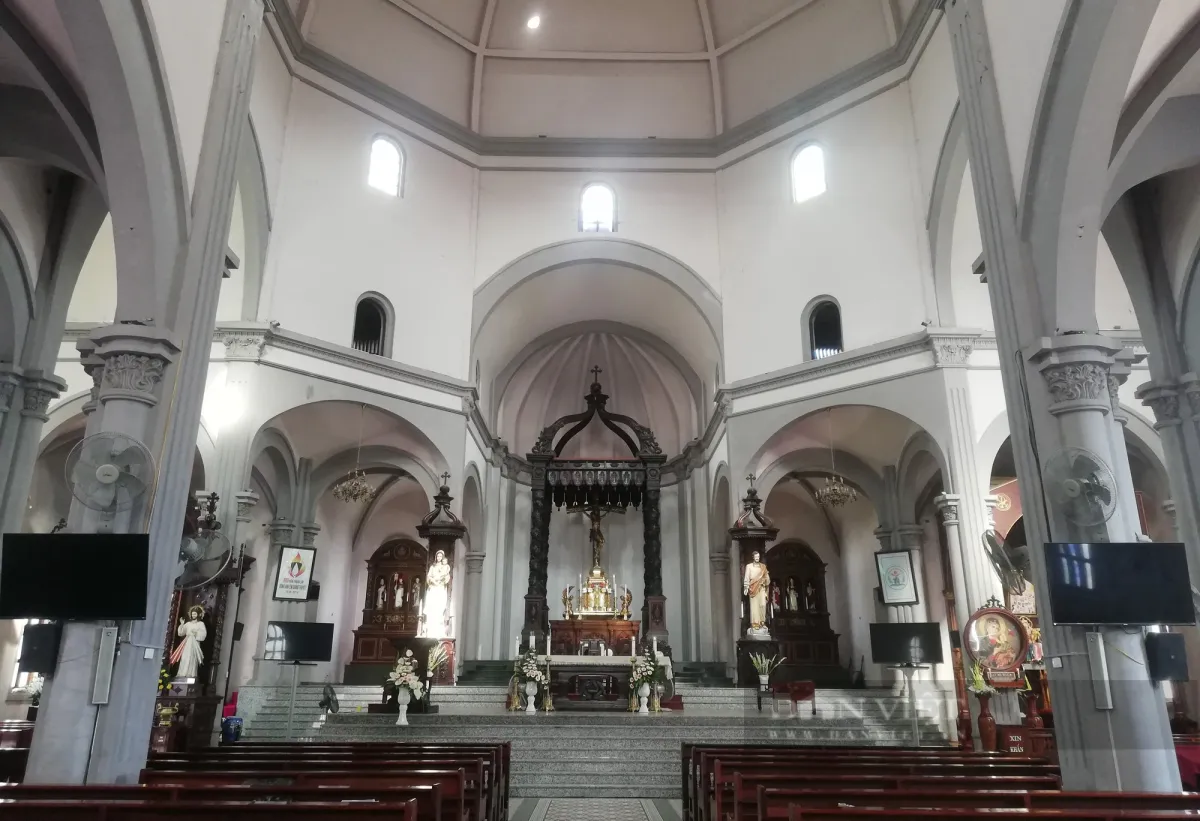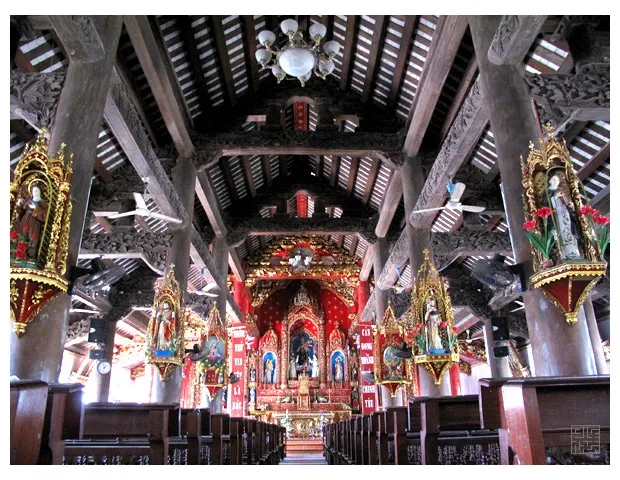Nam Dinh: The Land of Ancient Spiritual Architectural Heritage
Nam Dinh, a province in the Red River Delta, is not only famous for its Tam Xoan rice or traditional craft villages but also the cradle of Catholicism in Vietnam. Over hundreds of years, this place has witnessed the formation and development of a massive church system, carrying unique stories of history, architecture, and culture. These ancient Nam Dinh churches are not only symbols of faith but also living proof of an important part of the history of Nam Dinh churches and Nam Dinh heritage. Each structure is a work of art, a witness to time, containing timeless secrets and values.
The dense presence of ancient churches, especially in coastal districts like Hai Hau, Xuan Truong, and Giao Thuy, is the result of long-term missionary work and deep cultural integration between West and East. Gothic, Romanesque, Baroque architecture, or even a unique blend of European styles and traditional East Asian features, have created a diverse and rich picture. Stepping inside these structures, one can not only feel the majesty and sacredness but also immerse oneself in the beauty of the art, the sophistication in every detail, and the depth of the hidden history.
Great Architecture and Timeless Stories

The ancient churches of Nam Dinh are architectural epics carved from stone, brick, and wood. They are not merely places of worship but also living museums, preserving cultural, religious, and artistic values of the highest caliber. Every brick, every stained-glass window, every bas-relief tells a story about the life, faith, and resilience of the community.
Phu Nhai Basilica: A Symbol of Power and Faith
Standing majestically in Xuan Phuong commune, Xuan Truong district, Phu Nhai Basilica is one of the most magnificent ancient churches in Nam Dinh, dubbed the Catholic capital of the North. This structure stands out not only for its massive scale but also for its distinctive European Gothic architectural style, harmoniously combined with delicate East Asian features. With a bell tower height of nearly 44 meters, Phu Nhai rises like a spiritual lighthouse, visible from afar.
Inside the church, the vast space is designed with numerous large columns, pointed arches, and a system of giant stained-glass windows, recreating events from the Bible. Light passing through the stained glass creates an ethereal, sacred atmosphere, making everyone who enters feel overwhelmed and enveloped by a strange sense of peace. The exquisitely carved statues, detailed bas-reliefs, and altars made from precious woods and marble are not only religious objects but also masterpieces of art, showcasing the talent of ancient craftsmen. The history of Nam Dinh churches cannot be told without mentioning Phu Nhai, a place that has witnessed countless ups and downs, yet remains steadfast, affirming its position as an invaluable Nam Dinh heritage.
Hai Ly Ruined Church (Heart Church): The Beauty of Ruins and Nature's Revival
Unlike the majesty of Phu Nhai, Hai Ly Ruined Church (located in Hai Ly commune, Hai Hau district) possesses a desolate, contemplative, yet equally captivating beauty. This structure was once the Sacred Heart of Jesus Church, built in 1943. Due to sea erosion, the church was gradually abandoned, and now only the bell tower frame and a section of the rear wall remain, standing solitary amidst the vast beach.
The church's decay does not diminish its value; on the contrary, it creates a unique landscape that attracts many tourists and photographers. This ruined beauty serves as a reminder of the impermanence of time and the power of nature. Although it is now merely a relic, Hai Ly Ruined Church remains an important part of the story of ancient Nam Dinh churches, a symbol of resilience and faith, a Nam Dinh heritage deeply marked by time and the harshness of nature. Inside that empty frame is a space opened for imagination, where one can envision its golden era, and also where nature is gradually taking over, creating magnificent scenes.
Kien Lao Church: The Intersection of East-West Cultures
Located in Xuan Tien commune, Xuan Truong district, Kien Lao Church is a prime example of architectural cross-pollination between European Gothic style and details imbued with East Asian influences. Built in the late 19th century, the church has undergone numerous renovations and upgrades but has retained its ancient, majestic charm. Decorative motifs on the ceilings, columns, and bas-reliefs not only recreate biblical stories but also incorporate images of dragons, phoenixes, and lotus flowers – familiar symbols in Vietnamese culture.
Stepping into Kien Lao, visitors will feel an interesting contrast between its massive, sturdy exterior and the cozy, intimate interior. Natural light floods through the stained-glass windows, highlighting the meticulously carved details and vivid saint statues. The history of Nam Dinh churches through Kien Lao demonstrates architectural flexibility, how craftsmen skillfully combined two cultures to create a unique structure, becoming a proud Nam Dinh heritage.

Sculpture, Painting, and Profound Spiritual Meaning
Beyond their external architecture, what truly makes the ancient churches of Nam Dinh special is the artistic treasure trove hidden within. Each church is a colossal art gallery, where statues, paintings, stained-glass windows, and other decorative details all carry profound meaning, contributing to the creation of a mystical spiritual space.
You may need or be interested in
The saint statues are elaborately and meticulously carved from precious wood, stone, or plaster, showcasing the reverence and talent of the artisans. The facial expressions, costumes, and gestures of the figures are authentically depicted, conveying emotions and stories of the saints. Murals on walls or ceilings often recreate scenes from the Bible, miracles of God, or the lives of the apostles. Vibrant colors and tight compositions not only beautify the space but also serve an educational purpose, conveying messages of faith to the parishioners.
Notably, the stained-glass window system is one of the most prominent artistic highlights. These glass panels are composed of hundreds, even thousands, of small colored glass pieces, creating large, vivid images when sunlight shines through. The ethereal light filters into the church, creating a sparkling, mysterious atmosphere, enhancing the solemnity and sacredness of the place of worship. This is not only a high-level artistic technique but also a means of conveying religious stories and symbols visually and expressively, enriching the Nam Dinh heritage.
Nam Dinh Heritage: More Than Just Old Stone Walls
The ancient churches of Nam Dinh are not merely architectural structures. They are cultural symbols, living witnesses to the history of Nam Dinh churches, and an inseparable part of Nam Dinh heritage. They represent the resilience of a community, the blending and development of cultures, and the enduring power of faith.
Inside each church, there are not only stone columns and old walls but also the breath of the past, the echo of prayers, and the imprint of hundreds of generations who have placed their faith there. They are repositories of memories, places where people find peace, where traditional rituals are maintained through generations.
Preserving and Promoting Heritage Value
The preservation of ancient Nam Dinh churches is a major challenge but also an important responsibility. Churches not only face the erosion of time and nature but also need care to maintain their beauty and historical value. Many churches have been and are being restored and repaired, while ensuring that their original architectural features and spirit are preserved.
Besides physical preservation, promoting the value of these Nam Dinh heritage sites is also very important. Churches are not only spiritual destinations but also attractive tourist attractions, drawing visitors from both within Vietnam and abroad. By learning about the architecture, history, and culture of these churches, visitors can gain a deeper understanding of a unique aspect of Vietnam. This is how these values can be spread, recognized, and continue to live on in the hearts of future generations.
The century-old ancient churches in Nam Dinh are not merely solemn stone architectures. They are the heart of a culture, the breath of a long history, and a testament to the steadfastness of faith. Exploring inside these churches is discovering a world full of art, spirituality, and stories that time cannot erase. These are invaluable Nam Dinh heritage sites that need to be cherished and protected.
